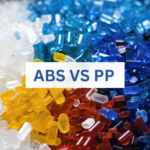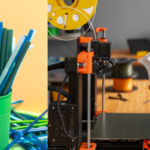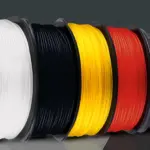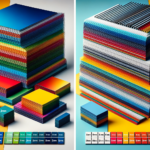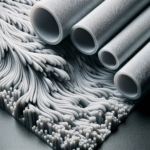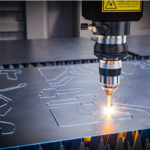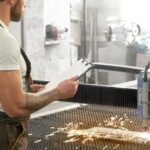Plasma cutting is generally more efficient when dealing with thicker metals, while laser cutting is faster and more precise when working with thinner resources. Evaluating the thickness of the material and considering the desired cutting speed and precision will help determine the most suitable cutting method for your project. As a matter of fact, Laser cutters have the capability to cut through metals with a thickness of up to 1 inch, whereas plasma cutting can handle metals that are 5 inches thick or even thicker.
When considering the best cutting solution for your project, it’s essential to evaluate the merits of laser cutting and plasma cutting. Both methods have distinct advantages and considerations based on various factors such as material thickness, cutting speed, precision requirements, and desired edge finish. By looking through these aspects mentioned in this blog post, you can make an informed decision that aligns with the specific needs of your project.
Table of Contents
Dive into Laser Cutting and Plasma Cutting
Laser Cutting and Plasma Cutting are popular techniques in metal fabrication and industrial manufacturing. Both methods precisely cut through various materials, including metal, wood, plastic, and more. Understanding the specific requirements of your project will help you determine which cutting method best fits your needs. Let’s dive into each technique and explore their differences and applications.
Laser Cutting
Laser cutting is a high-precision cutting process that uses a laser beam’s focused heat to melt or vaporise the material. The laser beam is generated by a laser resonator and directed onto the fabric using mirrors or fibre optics. The intense heat of the laser beam quickly cuts through the material along a predetermined path, creating a clean and precise cut.

Applications of Laser Cutting:
- Industrial manufacturing: Laser cutting is commonly used in industries such as automotive, aerospace, electronics, and signage for precise part fabrication.
- Prototyping: It is widely used to create quick and accurate prototypes in rapid prototyping processes.
- Art and design: Laser cutting allows artists and designers to create intricate patterns, engravings, and decorative pieces.
- Medical devices: Laser cutting is used to produce medical devices like stents, surgical instruments, and implants.
Advantages of Laser Cutting:
- High precision: Laser cutting offers exceptional accuracy, making it ideal for intricate and detailed designs.
- Versatility: It can cut various materials, including metals, plastics, fabrics, and wood.
- Clean cuts: Laser cutting produces clean edges without the need for additional finishing.
- Minimal material waste: The narrow laser beam minimises the material lost during cutting.
- Automation: Laser-cutting machines can increase efficiency and productivity.
Laser Cutting Limitations:
- Material Limitations: Not suitable for highly reflective or laser-energy-absorbing materials.
- Thickness Limitations: Decreased cutting speed and compromised quality for thicker materials.
- Cost: Expensive setup and maintenance, especially for small-scale operations.
- Heat Effects: Thermal damage to delicate or heat-sensitive materials.
If you are looking for laser cutting services for your project, our dedicated and experienced staff at Any Shape Plastics supply only the finest quality products to the Australian Market. Whether you require intricate designs, accurate prototypes, or precise part fabrication, we have the expertise and resources to deliver exceptional results. You can Contact Us today to discuss your laser cutting requirements and experience the quality and precision we are known for.
Plasma Cutting
Plasma cutting involves using a high-velocity jet of ionised gas, known as plasma, to melt and blow away the material being cut. A plasma-cutting machine generates an electric arc between an electrode and the workpiece, ionising the gas and creating plasma. The plasma, along with compressed air or gas, is directed onto the material, melting it and forming a cut.

Applications of Plasma Cutting:
- Metal fabrication: Plasma cutting is commonly used in metal fabrication industries for cutting metal sheets, pipes, and plates.
- Construction: It is used for cutting metal structures, beams, and pipes in construction projects.
- Automotive and shipbuilding: Plasma cutting is employed for manufacturing vehicle frames, chassis, and ship components.
- Scrap and recycling: Plasma cutting is used to dismantle and separate metal components in the recycling industry.
Advantages of Plasma Cutting:
- Faster cutting speeds: Plasma cutting is generally faster than laser cutting, making it suitable for thicker materials and bulk cutting.
- Cost-effective: Plasma cutting systems are often more affordable than laser cutting machines.
- Thick material capability: Plasma cutting can easily cut through thick metal plates, making it suitable for heavy-duty applications.
- Portability: Plasma cutting equipment can be portable, allowing on-site cutting for construction and repair work.
Plasma Cutting Limitations:
- Material Limitations: Primarily suitable for electrically conductive materials.
- Precision: Cut edges may have more slope and roughness, requiring additional finishing.
- Heat-Affected Zone (HAZ): Wider HAZ compared to laser cutting, affecting material properties.
- Noise and Fumes: Produces noise and emits fumes, requiring proper ventilation and safety measures.
A Comprehensive Comparison: Laser Cutting Vs Plasma Cutting
Initial Investment and Operating Costs:
- Laser Cutting: It generally requires a higher initial investment due to the cost of laser machines and maintenance. Operating costs can also be higher.
- Plasma Cutting: This method is often more affordable in terms of initial investment, and the operating costs are relatively lower compared to laser cutting.
Applications:
- Laser Cutting: Widely used in industries such as automotive, aerospace, electronics, signage, and prototyping for precise part fabrication, artistic designs, and medical devices.
- Plasma Cutting: Commonly used in metal fabrication, construction, automotive and shipbuilding industries for cutting thick metal plates, beams, pipes, and recycling applications.
Material Compatibility:
- Laser Cutting: Highly versatile and suitable for various materials, including sheet metals, plastics, fabrics, wood, and more.
- Plasma Cutting: Primarily used for cutting conductive materials, especially metals like steel, stainless steel, aluminium, and copper.
Precision and Accuracy:
- Laser Cutting: Offers exceptional precision and accuracy, making it ideal for intricate and detailed cuts, including sharp corners and fine details.
- Plasma Cutting: Plasma cutters provide good precision but may not match the intricacy and detail achievable with laser cutting.
Cutting Method:
- Laser Cutting: Laser cutters use a focused laser beam to melt or vaporise the material, resulting in precise and clean cuts.
- Plasma Cutting: Plasma cutters use a high-velocity jet of ionised gas (plasma) to melt and blow away the material, suitable for cutting electrically conductive materials.
Speed:
- Laser Cutting: Generally offers high speed for cutting, depending on the material and thickness.
- Plasma Cutting: This can achieve fast speed on cutting, especially for thicker materials.
Heat-Affected Zone (HAZ):
- Laser Cutting: Produces a narrower heat-affected zone, resulting in minimal distortion and heat damage to the material.
- Plasma Cutting: Generates a wider heat-affected zone, which can affect material properties near the cut.
Finish and Cleanliness:
- Laser Cutting: Produces clean and precise cuts with minimal additional finishing required.
- Plasma Cutting: May have slightly rougher edges, requiring additional finishing operations for certain applications.
Ultimately, the choice between laser and plasma cutting depends on factors such as material thickness, required precision, cutting method, speed, and specific project requirements. Evaluating these factors will help determine the best cutting solution for your project.
Use Laser Cutting Services at Any Shape Plastics;
Laser cutting was first developed in the 1960s and has revolutionised the manufacturing industry ever since. Its precise and versatile cutting capabilities have made it an indispensable tool in various fields, from automotive manufacturing to intricate artwork creation.
With over 27 years of experience in the cutting works industry, Any Shape Plastics has gained extensive expertise in precision cutting techniques, advanced machinery operation, and material selection. This deep understanding allows us to deliver superior cutting solutions, meeting our valued customers’ highest standards of quality and precision.
We value open communication with our customers and are always ready to assist you. If you have any inquiries, laser-related challenges, or specific requirements, our dedicated team is here to help. Feel free to Contact Us right away!
